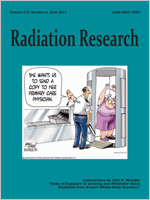We present a computational model for calculating the yield of radiation-induced chromosomal aberrations in human cells based on a stochastic Monte Carlo approach and calibrated using the relative frequencies and distributions of chromosomal aberrations reported in the literature. A previously developed DNA-fragmentation model for high- and low-LET radiation called the NASARadiationTrackImage model was enhanced to simulate a stochastic process of the formation of chromosomal aberrations from DNA fragments. The current version of the model gives predictions of the yields and sizes of translocations, dicentrics, rings, and more complex-type aberrations formed in the G0/G1 cell cycle phase during the first cell division after irradiation. As the model can predict smaller-sized deletions and rings (<3 Mbp) that are below the resolution limits of current cytogenetic analysis techniques, we present predictions of hypothesized small deletions that may be produced as a byproduct of properly repaired DNA double-strand breaks (DSB) by nonhomologous end-joining. Additionally, the model was used to scale chromosomal exchanges in two or three chromosomes that were obtained from whole-chromosome FISH painting analysis techniques to whole-genome equivalent values.
How to translate text using browser tools
10 April 2012
Computational Model of Chromosome Aberration Yield Induced by High- and Low-LET Radiation Exposures
Artem L Ponomarev,
Kerry George,
Francis A Cucinotta
ACCESS THE FULL ARTICLE

Radiation Research
Vol. 177 • No. 6
June 2012
Vol. 177 • No. 6
June 2012




